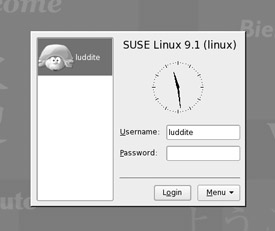Logging In
On the login screen, you can enter the username and password you created toward the end of the installation process. On the left side of the login screen, you should see a list of people who have accounts on your machine, as in Windows XP. You can click the user to have the username filled in automatically, as shown in Figure 7-2.

Figure 7-2. Select your username from the left side of the screen, type in your password, and click Login.
| Note | By clicking the Menu button at the bottom of the login screen dialog box, you can choose to reboot or shut down the machine without logging in. |
A common mistake among those who are new to Linux is to use the root account to log in on a daily basis, and therefore avoid using the standard user account created during setup. This is certainly possible, but it's not recommended. One of the reasons why Windows is so fundamentally insecure is that it allows all users to run with Administrator permissions by default. It is possible to run Windows with a limited account, but this must be specially configured by someone who knows what he or she is doing (you've got to love Microsoft's lackluster approach to security). This means that any Windows user can change the entire software and hardware settings of the PC.
In contrast, SUSE Linux prefers people to run as ordinary users. This is restrictive in the sense that it lets you run only particular programs and access certain pieces of hardware, but you shouldn't consider it a limitation. Consider it a security feature. In practice, this will not affect your day-to-day work with Linux.
If a situation arises where you need root powers—to run a program that configures hardware, for example—you'll be given the opportunity to switch temporarily to the root user account. You should find that an Administrator Password box appears, into which you can type the root password. Your root powers will apply to only that program, however, and in all other regards, you'll still be running Linux as an ordinary user. In many ways, this practice of borrowing root powers for certain tasks gives you the best of all worlds, but with minimal hassle.
EAN: 2147483647
Pages: 293
- Assessing Business-IT Alignment Maturity
- Measuring and Managing E-Business Initiatives Through the Balanced Scorecard
- Measuring ROI in E-Commerce Applications: Analysis to Action
- Technical Issues Related to IT Governance Tactics: Product Metrics, Measurements and Process Control
- The Evolution of IT Governance at NB Power